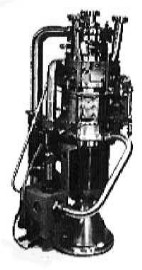Updated: 28-Apr-2020
In 1958, Ludwig Bölkow started in Ottobrunn the development of a rocket engine considered "green" for consuming liquid oxygen and kerosene.
-The first tests were made in 1963 with the engine giving 50 kN of thrust.
Ottobrunn's team joined the one in Lampoldshausen to continue experimenting with rocket engines.
-In 1966 they made an engine running on hydrogen. In 1970 on fluorine.
-The first hydrogen-powered pulsating rocket engine, in 1972.
-About 1992 a hypersonic ramjet was made.

“50 kN engine”
-From 1968 there is another rocket engine with liquid hydrogen and oxygen that gave 180 kN.
-They participated in the development of the HM-7 engine of the Ariane's upper stage. It used a regenerative cooling system, that is, the hydrogen is used for cooling the chamber before entering it for combustion.
-The Lampoldshausen team built bi-fuel engines for the European Symphonie satellite. They were one apogee engine giving 400 kN and seven maneuver and control engines delivering 10N. Year 1974.
A rocket-ramjet operating at Mach 4 from 1988 is known. They continue with the study of turbo-ramjet for future hypersonic aircraft.
Engines of LUDWIG BÖLKOW
Model: Ramjets
Arquitecture:
Chambers:
Fuels:
Feed System:
Ignition:
Thrust:
Weight:
Model: Rocket engines
Arquitecture:
Chambers:
Fuels:
Feed System:
Ignition:
Thrust:
Weight:


